Themed collection Mechanistic Organometallic Chemistry

Front cover
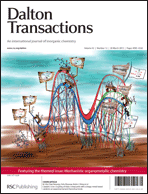
Inside front cover
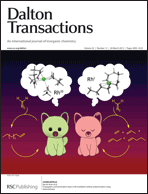
How far have we come?
Welcome to this Dalton Transactions themed issue on Mechanistic organometallic chemistry.

Dalton Trans., 2013,42, 4104-4104
https://doi.org/10.1039/C3DT90013D
Deuteration of boranes : catalysed versus non-catalysed processes
Borane and alkylboranes can undergo deuteration in the absence of a catalyst, while pincolborane and catchecol borane cannot; an iridium complex is shown to catalyse the deuteration of the latter compounds.
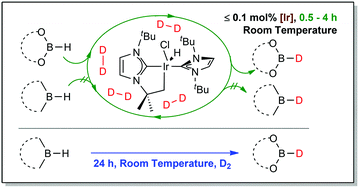
Dalton Trans., 2013,42, 4105-4109
https://doi.org/10.1039/C3DT33045A
Solvent effects on Grubbs’ pre-catalyst initiation rates
Initiation rates for Grubbs and Grubbs–Hoveyda second generation pre-catalysts have been measured accurately in a range of solvents. No simple correlations to single solvent properties were discovered; instead, a multi-parameter approach was necessary to correctly treat the experimental data.
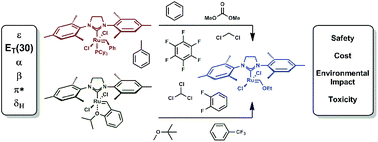
Dalton Trans., 2013,42, 4110-4113
https://doi.org/10.1039/C2DT32441E
Computational study on mechanism of Rh(III)-catalyzed oxidative Heck coupling of phenol carbamates with alkenes
A mechanistic study on the Rh(III)-catalyzed oxidative Heck coupling of phenol carbamates with alkenes has been performed with DFT calculations.
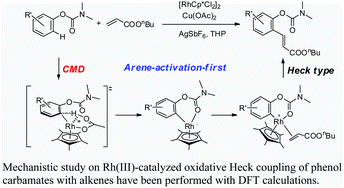
Dalton Trans., 2013,42, 4175-4184
https://doi.org/10.1039/C3DT31898B
Ethylene polymerisation and oligomerisation with arene -substituted phenoxy-imine complexes of titanium: investigation of multi-mechanism catalytic behaviour
A range of arene-substituted phenoxy-imine complexes of Ti(IV) have been prepared and evaluated in ethylene oligomerisation and polymerisation.
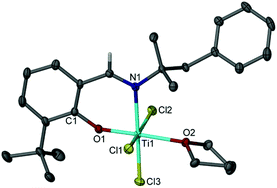
Dalton Trans., 2013,42, 4185-4196
https://doi.org/10.1039/C3DT32183E
Understanding intermolecular C–F bond activation by a transient titanium neopentylidyne: experimental and theoretical studies on the competition between 1,2-CF bond addition and [2 + 2]-cycloaddition/β-fluoride elimination
The mechanisms to C–F bond activation of fluoropyridines by a transient titanium alkylidyne are presented.
![Graphical abstract: Understanding intermolecular C–F bond activation by a transient titanium neopentylidyne: experimental and theoretical studies on the competition between 1,2-CF bond addition and [2 + 2]-cycloaddition/β-fluoride elimination](/en/Image/Get?imageInfo.ImageType=GA&imageInfo.ImageIdentifier.ManuscriptID=C3DT32570A&imageInfo.ImageIdentifier.Year=2013)
Dalton Trans., 2013,42, 4163-4174
https://doi.org/10.1039/C3DT32570A
C–N coupling in the gas-phase reactions of ammonia and [M(CH)]+ (M = Ni, Pd, Pt): a combined experimental/computational exercise
Electrospray ionization of methanolic solutions of monomeric nickel(II) acetate and tetrameric platinum(II) acetate leads to the formation of the corresponding methylidyne complexes [M(CH)]+ (M = Ni, Pt), which react with ammonia under C–N coupling.
![Graphical abstract: C–N coupling in the gas-phase reactions of ammonia and [M(CH)]+ (M = Ni, Pd, Pt): a combined experimental/computational exercise](/en/Image/Get?imageInfo.ImageType=GA&imageInfo.ImageIdentifier.ManuscriptID=C3DT32596B&imageInfo.ImageIdentifier.Year=2013)
Dalton Trans., 2013,42, 4153-4162
https://doi.org/10.1039/C3DT32596B
Catalytic cross-coupling of diazo compounds with coinage metal-based catalysts : an experimental and theoretical study
Two diazo compounds can be coupled to form an olefin in a reaction catalyzed by copper and silver complexes.
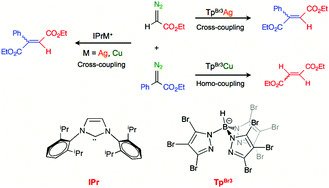
Dalton Trans., 2013,42, 4132-4138
https://doi.org/10.1039/C2DT32439C
Accelerating Ni(II) precatalyst initiation using reactive ligands and its impact on chain-growth polymerizations
Initiation rates were selectively accelerated in Ni-catalyzed chain-growth polymerizations using aryl-functionalized precatalysts.
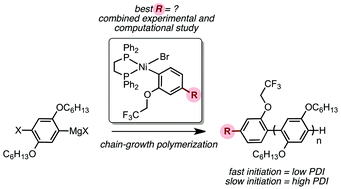
Dalton Trans., 2013,42, 4218-4222
https://doi.org/10.1039/C2DT32735J
Computational study of the double C–Cl bond activation of dichloromethane and phosphine alkylation at [CoCl(PR3)3]
The double C–Cl activation of CH2Cl2 at [CoCl(PMe3)3] has been modelled with DFT calculations.
![Graphical abstract: Computational study of the double C–Cl bond activation of dichloromethane and phosphine alkylation at [CoCl(PR3)3]](/en/Image/Get?imageInfo.ImageType=GA&imageInfo.ImageIdentifier.ManuscriptID=C2DT32272B&imageInfo.ImageIdentifier.Year=2013)
Dalton Trans., 2013,42, 4208-4217
https://doi.org/10.1039/C2DT32272B
Radical-chain oxidative addition mechanism for the reaction of an [Re(CO)5]− anion with α-bromostilbene
An oxidative addition reaction of α-bromostilbene to Na[Re(CO)5] carbonylmetallate is shown to proceed by a radical-chain mechanism involving a 17-electron [Re(CO)4{C(Ph)![[double bond, length as m-dash]](https://www.rsc.org/images/entities/char_e001.gif) CHPh}]˙− radical-anion intermediate.
CHPh}]˙− radical-anion intermediate.
![Graphical abstract: Radical-chain oxidative addition mechanism for the reaction of an [Re(CO)5]− anion with α-bromostilbene](/en/Image/Get?imageInfo.ImageType=GA&imageInfo.ImageIdentifier.ManuscriptID=C2DT32552G&imageInfo.ImageIdentifier.Year=2013)
Dalton Trans., 2013,42, 4223-4232
https://doi.org/10.1039/C2DT32552G
Propagation and termination steps in Rh-mediated carbene polymerisation using diazomethane
RhIII species were found to be the active species involved in the formation of long polymers in the Rh-mediated carbene polymerisation of diazomethane, while RhI species are involved in the formation of short oligomers and dimers.
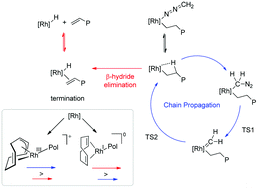
Dalton Trans., 2013,42, 4139-4152
https://doi.org/10.1039/C2DT32584E
Platinum(II) and platinum(IV) complexes stabilized by abnormal/mesoionic C4-bound dicarbenes
C4-bound imidazolylidene-type dicarbene ligands bound to platinum(II) centers induce solvolysis of the metal-bound halide and facile oxidative addition to yield stable platinum(IV) complexes.
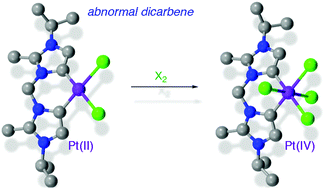
Dalton Trans., 2013,42, 4197-4207
https://doi.org/10.1039/C2DT32423G
Computational Hammett analysis of redox based oxy-insertion by Pt(II) complexes
A computational Hammett study is performed comparing non-redox and redox mechanisms for late transition metal mediated carbon–oxygen bond formation.
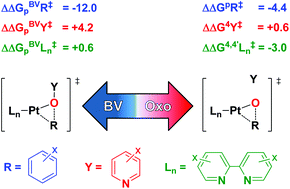
Dalton Trans., 2013,42, 4114-4121
https://doi.org/10.1039/C2DT31983G
A combined NMR /DFT study on the ion pair structure of [(PR12R2)Au(η2-3-hexyne)]BF4 complexes
The effect of the electronic properties of a P-ligand on the ion pair structure of the catalytically relevant [(PR12R2)Au(η2-3-hexyne)]BF4 ion pairs has been investigated by combining 19F, 1H-HOESY NMR and relativistic DFT calculations.
![Graphical abstract: A combined NMR/DFT study on the ion pair structure of [(PR12R2)Au(η2-3-hexyne)]BF4 complexes](/en/Image/Get?imageInfo.ImageType=GA&imageInfo.ImageIdentifier.ManuscriptID=C2DT32260A&imageInfo.ImageIdentifier.Year=2013)
Dalton Trans., 2013,42, 4122-4131
https://doi.org/10.1039/C2DT32260A
About this collection
This themed issue, guest edited by Professor Bob Crabtree, aims to highlight the importance of mechanism to the field of organometallic chemistry. Read below for a selection of both theoretical and experimental research contributions, providing deeper insight into current problems.